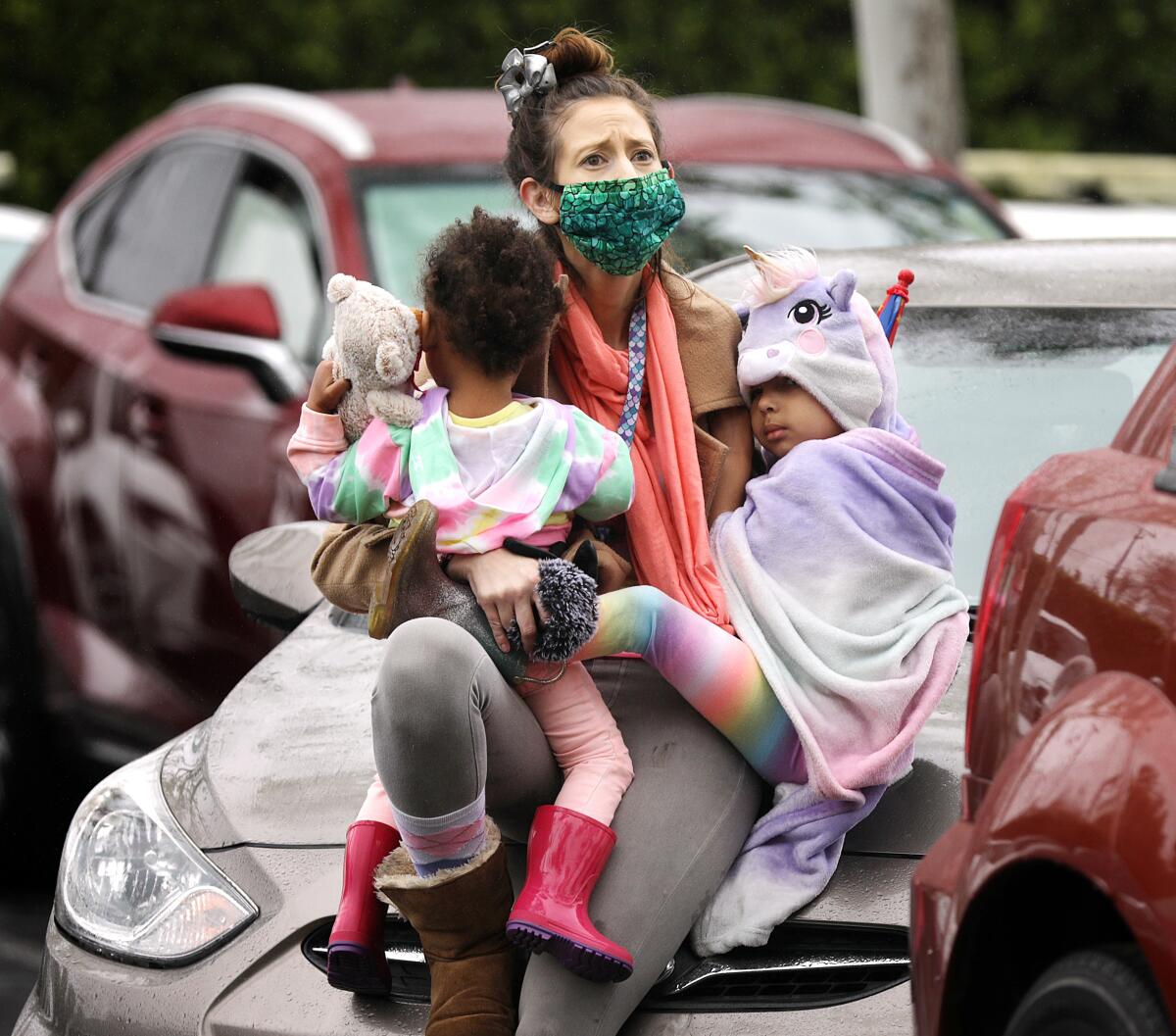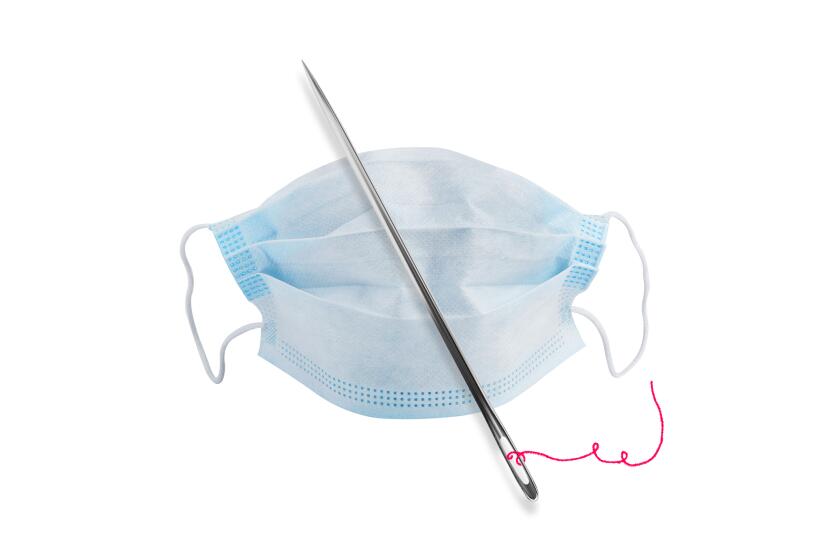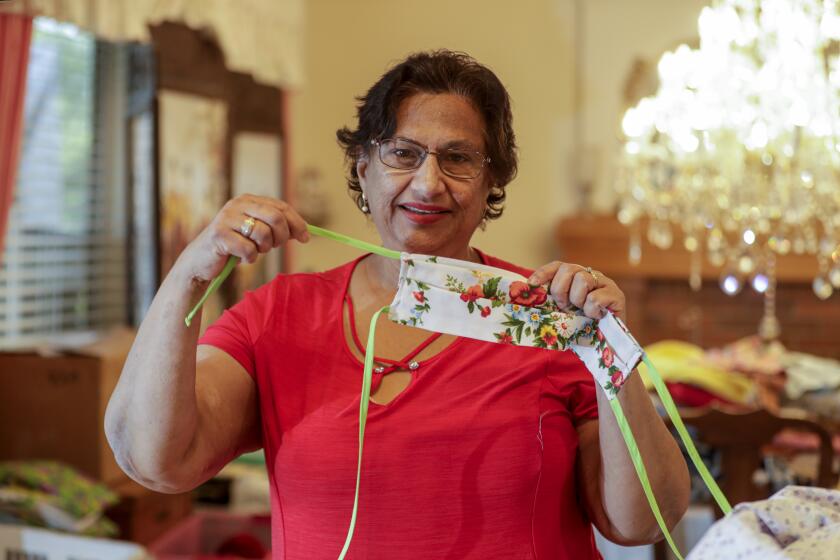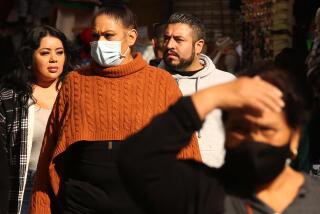L.A. County now requires residents to wear face coverings. Here are the details

Los Angeles County’s new requirement on wearing face coverings went into effect Wednesday night. Here’s a look at how that new law works, as well as similar orders around California.
How does L.A. County’s face-covering order work?
Customers of essential businesses are required to wear a face covering while inside.
Also, employers of essential businesses must give all employees whose duties require contact with other people a cloth face covering to wear while working with other people.
Do I have to wear it while in the backyard or walking alone outside?
The L.A. County order, effective for all 10 million people who live in Los Angeles County, does not require mask-wearing while in the backyard or while on a solitary run or walk.
Barbara Ferrer, director of the Los Angeles County Department of Public Health, said wearing face coverings protects other people from your germs in case you’re infected and don’t realize it.
She suggested wearing the face covering while you’re in places with other people, such as on a bus or a train while making an essential trip.
“If you’re all by yourself ... you can put it on if you want to, but you’re not required to,” Ferrer said.
People who live together also are not required to wear masks while on a walk or a jog, Los Angeles Mayor Eric Garcetti said.
The cities of Long Beach and Pasadena, which have their own health departments, issued similar orders to be consistent with L.A. County’s order. A similar order for the city of Los Angeles, with a population of 4 million people, went into effect Friday.
DIY coronavirus mask instructions from crafters and doctors.
Have some cities issued even stronger face-covering rules?
Beverly Hills and Glendale require face coverings whenever people leave home, including for walks through the neighborhood.
Under the order, drivers traveling alone or with members of their households do not need to wear face coverings unless they lower their vehicle’s windows for any reason, including to interact with first responders, food service workers or others who are not members of their household.
What about other counties in Southern California?
San Diego County requires employees who may have contact with the public to wear a cloth face covering, such as in grocery stores, pharmacies, convenience stores, gas stations and banks, as well as on public transit and for childcare providers while serving food.
Orange County is strongly encouraging residents to wear face coverings when leaving home, as well as employees at essential businesses while working. The city of Costa Mesa, however, is generally making face coverings mandatory when residents or visitors are outside their home or personal vehicle while performing or accessing an essential service.
Riverside County requires everyone to wear a face covering when leaving home.
San Bernardino County requires everyone to wear a face covering when outside the home for essential activities.
Ventura County is urging residents to wear a face covering if they will be around others.
Face coverings and masks may help to stem the spread of the coronavirus. But how to keep them clean?
What about the San Francisco Bay Area?
A number of San Francisco Bay Area counties, including San Francisco, Alameda, Contra Costa, San Mateo and Marin, are requiring face coverings for people when they are outside their homes to access essential businesses such as grocery stores or pharmacies, while seeking healthcare services and while waiting for and riding public transit. Masks aren’t required for children 12 or younger. They also aren’t required while at home, in cars alone or with members of the same household or while walking, hiking, cycling or running outdoors, although people are asked to have one readily accessible.
Sonoma County is requiring people to wear face coverings before entering any indoor facility outside their home, such as grocery stores, dry cleaners, offices and post offices; in any enclosed open space, like construction sites; in taxis, ride-hail vehicles and buses; and in outdoor areas when people are unable to keep six feet away from others at all times, such as farmers markets, gas stations and drive-thrus.
Santa Clara County is urging people to wear face masks in public.
What do state and federal authorities say?
The U.S. Centers for Disease Control and Prevention recommends wearing cloth face coverings in public settings such as grocery stores and pharmacies, where it can be hard to keep six feet away from other people.
The California Department of Public Health says wearing face coverings may reduce asymptomatic transmission of the virus and reinforce physical distancing.
“There is limited evidence to suggest that use of cloth face coverings by the public during a pandemic could help reduce disease transmission,” the agency said. “Their primary role is to reduce the release of infectious particles into the air when someone speaks, coughs or sneezes, including someone who has COVID-19 but feels well.
“Cloth face coverings are not a substitute for physical distancing and washing hands and staying home when ill, but they may be helpful when combined with these primary interventions,” the agency said.
What kinds of face coverings are acceptable?
Bandannas, fabric masks and neck gaiters are permitted. Officials are urging residents to reserve medical-grade masks and N95 respirators for medical professionals and first responders.
How should I care for my face covering?
Here’s some advice by California health officials:
- It’s a good idea to wash your cloth face covering frequently, ideally after each use, or at least daily.
- Have a bag or bin to keep cloth face coverings in until they can be laundered with detergent and hot water and dried on a hot cycle.
- If you must re-wear your cloth face covering before washing, wash your hands immediately after putting it back on and avoid touching your face.
- Discard cloth face coverings that no longer cover the nose and mouth, have stretched-out or damaged ties or straps, cannot stay on the face or have holes or tears in the fabric.
More to Read
Start your day right
Sign up for Essential California for news, features and recommendations from the L.A. Times and beyond in your inbox six days a week.
You may occasionally receive promotional content from the Los Angeles Times.










